Acrylic paint is usually not toxic, and very safe to use. It is only toxic when used for airbrushing and when sanded, due to the chemicals in the air. For every day painting and projects, acrylic is non-toxic.
The reason why most acrylic paints are not toxic is because they are water-based, and being water based paints make it easy to clean with soap and water, without the use of any toxic cleaning chemicals. I personally use this Arteza Acrylic Paint Set, the quality is amazing and they’re also non-toxic.
While acrylic paint can release some type of chemical in the air as they’re drying, just make sure that you have plenty of ventilation as you paint. The easy non toxic cleanup of acrylic paints is one reason why I favor them over oil paints.
If you have really sensitive skin, a simple safety measure is to wear gloves when you paint. Nitrile-coated gloves keep paint, solvents, and mediums from being absorbed into your skin, and they have the added benefit of keeping your hands free of dried paint, which with some acrylics can be hard to wash off when dry.
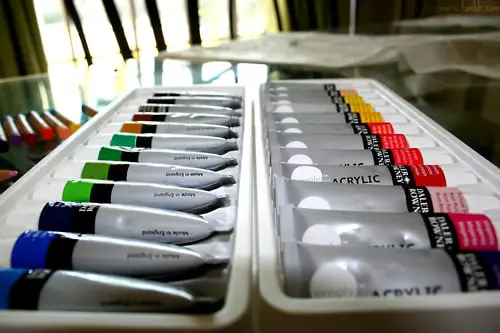
You can buy comfortable gloves with a breathable back and coated palms and fingers from any garden or hardware store.
The acrylic colors that contain toxic chemicals will have it marked on the label – these include cadmium, cobalt, manganese, chromium, and lead. When you do use acrylics for airbrushing the first thing you want to do is put on a mask, because particles will get into your lungs.
Make sure to use a really good filter mask designed to fit the face well, seriously good ventilation, like outside or an open garage, and make sure your paints are certified for spraying (low inhalation toxicity), then go for it.
Remember to paint away from people as they can inhale the toxic fumes, and if you feel dizzy or get a headache it’s time for a break and some fresh air.
Is Acrylic Paint Safe for Kids?
Acrylic paints are typically safe for kids, when used properly. My kids paint with non-toxic acrylic paints and not only is it safe but really easy to clean up. Some soap and water will usually get it off their skin and the area they were painting. Make sure your kids understand that acrylic paint should only be used on the canvas and nowhere else.
My top recommendation for kid’s paint is this Arteza Tempera Set. It’s non-toxic, and made specifically for kids. My kids love this set so much, I’m always replenishing it in my home.
Some paints do contain chemicals which can irritate their skin. Keep in mind that some children have more sensitive skin than others so the paint to skin contact might irritate some, while others are fine.
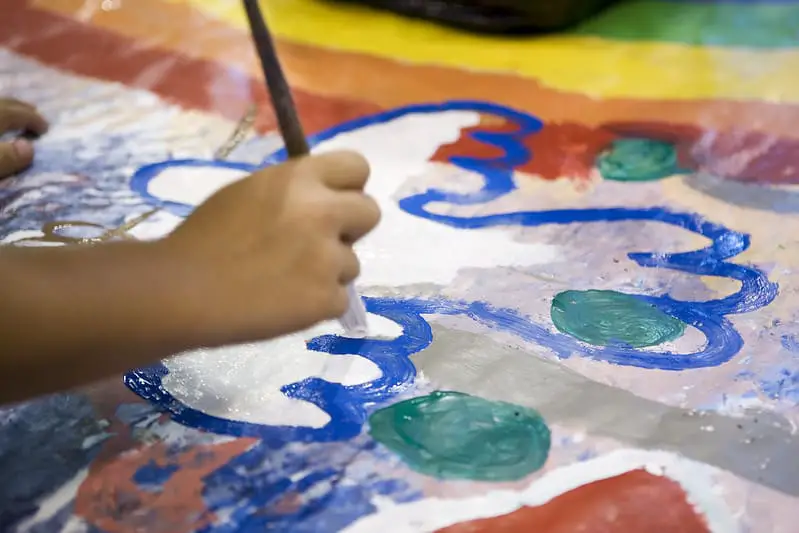
According to Pediatric Safety, acrylic paint poisoning is not likely when a small amount is ingested, but it could be when a large amount is involved. Physical contact with acrylic paint can also cause more than just an upset stomach.
Also, according to the U.S. Consumer Product Safety Commission, some water-based acrylic paints contains ammonia and formaldehyde, which can cause respiratory irritation if ingested. The commission further noted that solvent-based acrylics contain turpentine, xylene, toluene, and methyl ethyl ketone, which are toxic when inhaled.
But as I mentioned above, it’s totally safe for kids to use acrylic paints. Just remember to reiterate to the smaller kiddos that the paint should only go on the canvas. Always supervise when younger children are painting and everything should be okay. Kids will love how vibrant the colors are and how much fun painting with acrylic is. Acrylic paints are richly pigmented and mix well.
They are the most permanent option and are water-resistant. Acrylic paint is best used on paper, wood and canvases. Though acrylic paints labeled “non-toxic” are safe, some parents with younger toddlers prefer other craft paints. If you are still unsure about letting your little ones paint with acrylics, here are some other options for the younger kids.
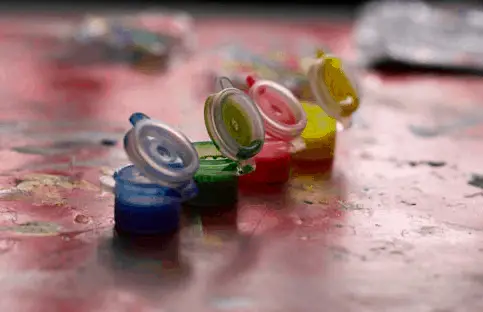
- Tempera Paint: Tempera paint is not permanent, so it’s a great option for kids. It mixes very well and is also thinner and more liquid than acrylic paint. However, it’s important to note that tempera paint doesn’t have the same shine you get with acrylic paint.
- Activity Paint: Activity paint is a water-based gel that washes easily — it’s another great option if you’re worried about your kids getting paint everywhere. This paints are specifically designed for the various “activities” kids get up to in art class!
- Watercolor Paint: Watercolor is the most watery option, which is why it’s perfect for kids that spread paint around your house.
- Finger Paint: Last on our list is finger paint. Who doesn’t remember getting into finger paint and drawing with their pointer finger? These paints are typically thicker, so make sure you have paper or material that can match.
Is Acrylic Paint Safe for Baby Hand Prints?

As a parent, you likely will want to remember how precious and tiny your child once was — or measure how she’s growing over time. You can do this by preserving your child’s hand print, which makes a great keepsake or gift for grandparents.
But is acrylic paint safe for your baby’s hand print project? Typically not. Because a new baby’s skin is so sensitive and brand new, it’s not recommended to put acrylic paint on those little hands.
A great paint for baby hand prints is Tempera Paint. It’s the first on my list above for alternatives to acrylic paint. They are non toxic, and perfect for hand print projects as they thick in consistency and not runny.
A plus is that it washes off with just some soap and water, and they don’t have the chemicals that some acrylic paints do. Tempera paints would be my go to for my little one’s hand print project.
Is Acrylic Paint Toxic to Pets?

Water-based paints such as acrylic paint may irritate a dog or cat’s skin, but they’re typically not thought of as toxic.
However, large ingestion of paint may cause your animal to become sick.
How toxic paint is to your animal will depend on a variety of factors like the contents of the paint, the animals weight, etc. Keep an eye on your animal if you expect they may have consumed a significant amount of paint.
If you know or suspect that your dog or cat has been exposed to paint, call your veterinarian or Pet Poison Helpline for instructions. VCA Hospitals notes the following signs of paint poisoning in animals:
- Vomiting
- Diarrhea
- In-coordination or difficulty walking or standing (wobbling)
- Depression or lethargy
- Tremors
- Difficulty breathing
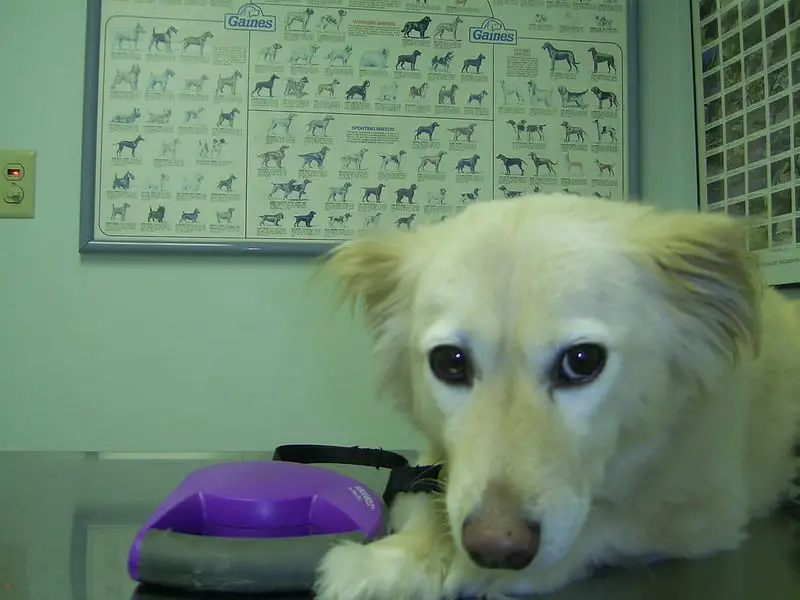
Apart from an accidental ingestion of paint for your pet, it is perfectly safe for you fur buddy to participate in your art or craft projects. Use only non-toxic paints that wash away easily to protect your dog and your floors after the painting project is complete.
Ideally, work with pets and paints outdoors; this way, even if your favorite furry friends run around with paint on their paws, the paint stays outside, and your home remains paw-print free.
Is Acrylic Paint Toxic to Dogs?
Some dogs get into literally everything! While acrylic paint is non-toxic, like mentioned above, if ingested in large amounts, it can upset your dogs stomach. Acrylic paint is typically not toxic to dogs, and some fur parents even do dog paw projects which are so cute and fun!

If your dog happens to chew up a paint roller that still has paint on it, simply have your dog drink some water and monitor him. Acrylic paint does not lead like some of the older type of paints that would cause harm to your fur buddies insides, so they will be fine.
If you do notice that your dog seems unwell, a trip to the vet should be considered but speaking from personal experience, they might have an upset stomach or even spit out some of it, but it’s just as if they had gotten into some trash or other things they weren’t supposed to.
If you want to do a paw project, before you start painting those paws, make sure to inspect and clean them very well. You’ll want to check them for any cuts or injuries. Wipe off paws with damp paper towels, or dip them in warm, soapy water and wipe them off with a soft cloth afterwards.
Wipes designed specifically for dog paws offer a quick way to clean those paw if the paws aren’t very dirty. Washable acrylic paints or finger paints designed for young children work equally well for pet paw prints. Since the paints are designed for children to use directly on their skin, the paints are non-toxic.
Squirt a little of the desired color onto a disposable plate; then brush the paint onto clean paw pads with a foam brush or paintbrush. Press the painted paw onto the project surface; then rinse the paw off immediately with a hose or in a warm tub of water.
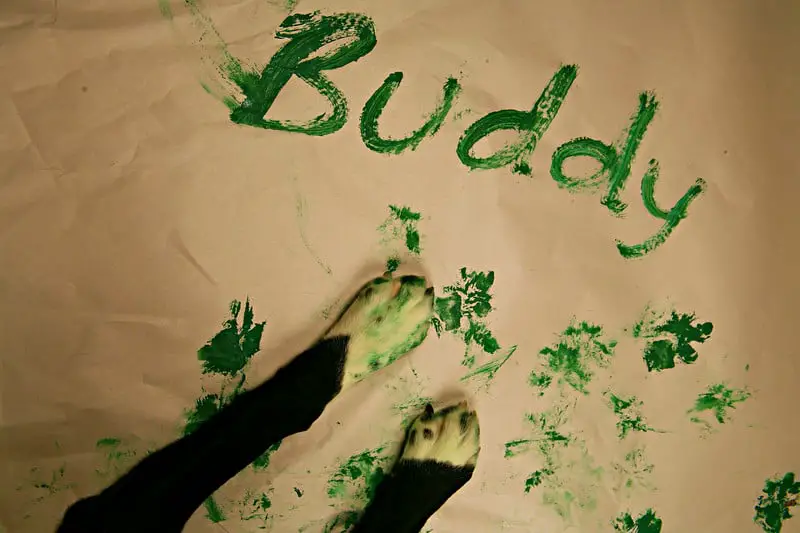
Water-based paints such as non-toxic acrylic craft paints provide an inexpensive mean of capturing your dog’s paw prints. Acrylic paints create deep opaque prints for your fun pet project. When using acrylics, brush on a layer thick enough to capture the print; then press the paw onto the project surface.
Fun Thought: If space allows, create a large acrylic paw-print painting by dipping each paw into paint. Allow the dog to run across a large sheet of paper such as a roll of butcher paper unrolled across the yard. Wash the paws off within a few minutes before the paint dries.
Is Acrylic Paint Toxic to Cats?
Curiosity killed the cat who ate some acrylic paint right? Not quite! Acrylic paint is not toxic to cats, but it can get messy if they roll onto it and get paint all over their fur. Just make sure you know that there’s no lead or any other harmful chemicals in the paint.

Acrylic paint is non-toxic so if your cat ingested a small amount, they will most likely expel later on or they might not. Make sure to read the warning signs above to monitor your cat, and see if thy do need a trip to the vet. Unless your curious cat ate an entire can of paint, they should be fine.
If you want to flush your cat’s mouth to get the taste out, I would just suggest offering a light meal (ie boiled chicken, white fish, scrambled egg, etc) and encourage them to drink (you can use water but also low salt chicken broth or cat milk) to dilute what she has ingested. This will reduce the risk of associated GI upset for your kitty.
If your curious cat somehow manages to actually drink some of the water that maybe had your brushes in, unless they are vomiting non-stop, they should still be fine.
As always with any project, prepare all of your materials, keep things safe, and remember to have lots of ventilation.
Happy Painting!

